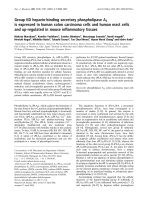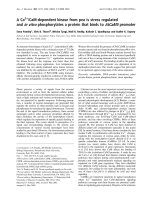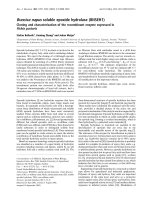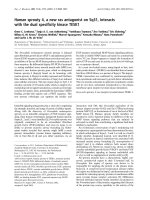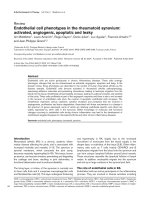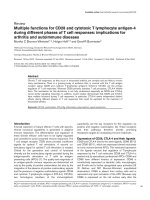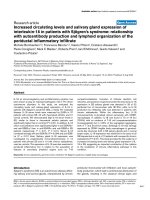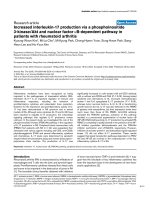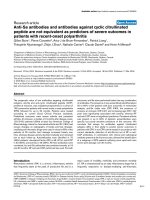Báo cáo y học: "Endothelial Circulating soluble urokinase plasminogen activator receptor is stably elevated during the first week of treatment in the intensive care unit and predicts mortality in critically ill patients" potx
Bạn đang xem bản rút gọn của tài liệu. Xem và tải ngay bản đầy đủ của tài liệu tại đây (412.48 KB, 14 trang )
RESEARCH Open Access
Circulating soluble urokinase plasminogen
activator receptor is stably elevated during the
first week of treatment in the intensive care unit
and predicts mortality in critically ill patients
Alexander Koch
1
, Sebastian Voigt
1
, Carsten Kruschinski
2
, Edouard Sanson
1
, Hanna Dückers
1
, Andreas Horn
1
,
Eray Yagmur
3
, Henning Zimmermann
1
, Christian Trautwein
1
and Frank Tacke
1*
Abstract
Introduction: suPAR is the soluble form of the urokinase plasminogen activator receptor (uPAR), which is
expressed in various immunologically active cells. High suPAR serum concentrations are suggested to reflect the
activation of the immune system in circumstances of inflammation and infection, and have been associated with
increased mortality in different populations of non-intensive care patients. In this study we sequentially analyzed
suPAR serum concentrations within the first week of intensive care in a large cohort of well characterized intensive
care unit (ICU) patients, in order to investigate potential regulatory mechanisms and evaluate the prognostic
significance in critically ill patients.
Methods: A total of 273 patients (197 with sepsis, 76 without sepsis) were studied prospectively upon admission
to the medical intensive care unit (ICU), on Day 3 and Day 7, and compared to 43 healthy controls. Clinical data,
various laboratory parameters as well as investigational inflammatory cytokine profiles were assessed. Patients were
followed for approximately one year.
Results: Upon admission to the ICU suPAR serum concentrations were elevated in critically ill patients as
compared with healthy controls. In sepsis patients suPAR levels were higher than in non-sepsis patients (with or
without systemic inflammatory response syndrome (SIRS)). During the first week after admission to the ICU serum
suPAR concentrations remained stably elevated . suPAR serum concentrations measured upon admission were
closely and independently correlated to various laboratory parameters, specifically biomarkers of inflammation
(tumor necrosis factor (TNF), C-reactive protein (CRP)), hepatic and renal dysfunction. High suPAR levels at
admission and at Day 3 were a strong independent predictor for both ICU and long-term mortality in critically ill
patients.
Conclusions: In sepsis and non-sepsis patients suPAR serum concentrations are increased upon admission to the
ICU, likely reflecting the activation state of the immune system, and remain stably elevated in the initial course of
treatment. Low suPAR levels are a positive predictor of ICU- and overall survival in critically ill patients, including
sepsis and non-sepsis patients. Aside from its value as a promising new prognostic biomarker, both experimental
and clinical studies are required in order to understand the specific effects and regulatory mechanisms of suPAR in
SIRS and sepsis, and may reveal new therapeutic options.
* Correspondence:
1
Department of Medicine III, RWTH-University Hospital Aachen,
Pauwelsstrasse 30, 52074 Aachen, Germany
Full list of author information is available at the end of the article
Koch et al. Critical Care 2011, 15:R63
/>© 2011 Koch et al.; licensee BioMed Central Ltd. This is an open access article distributed under the terms of the Creative Commons
Attribution Lice nse (http://c reativecommons.org/licenses/by/2.0), which permits unrestricted use, distribution, and reproduction in
any medium, provided the original work is properly cited.
Introduction
The urokinase plasminogen activator receptor (uPAR) is
expressed on diff erent cell types including neutrophils,
lymphocytes, monocytes, macrophages, certain c ancer
cells and vascular endothel ial cells. uPAR and its liga nd
urokinase plasminogen activator (uPA) are participants
in numerous immunologi c functions including migra-
tion, adhesion, angiogenesis, fibrinolysis and cell prolif-
eration and have been found to promote tissue invasion
in malignant diseases b y converting plasminogen into
plasmin, resul ting in degradation of extracellular matrix
[1-4]. Migration of inflammatory cells from the blood
stream into tissues is also an essential component of
inflammation and immune response against infection, in
which the uPAR/uPA system is directly involved [5].
Through inflammatory stimulation uPAR is cleaved
from the cell surface by proteases to the soluble form of
the receptor, suPAR, which has been detected in blood,
urine and cerebro-spinal fluid [6-9]. Increased activation
of the immune system caused by different types of infec-
tions or various solid tumours, results in increased
suPAR concentrations in body fluids. Thereby serum
suPAR levels are believed to mirror the degree of immu-
noactivation. Moreover, high suPAR serum concentra-
tions have been found to pre dict mortality in patients
with active tuberculosis and in healthy subjects [10]. I n
a recent study, high suPAR serum concentrations have
been shown to indicate a poor outcome in patients with
systemic inflammatory response syndrome (SIRS)
admitted to an emerge ncy department and to a depart-
ment of infectious diseases without an intensive-care
environment [11]. Yet, these findings have been
regarded as possibly applicable only to patients with
community-acquired infections, which did not require
intensive-treatment, and the validity for critically ill
patients was questioned.
Thepresentstudywasconductedwithalargecohort
of well characterized critically ill patients in a medical
ICU to provide information on suPAR serum concentra-
tions in different circumstances of critical disease, to
identify potential regulatory m echanisms of suPAR by
correlations with a wide number of markers of inflam-
mation, organ dysfunction and metabolism and to eluci-
date the prognostic impact of suPAR in critically ill
patients.
Materials and methods
Study design and patient characteristics
The study protocol was approved by the local ethics
committee and conducted in accordance with the ethical
standards laid down in t he 1964 Declaration of Helsinki
(ethics committee of the University Hospital Aachen,
RWTH-University, Aachen, Germany, reference number
EK 150/06). We enrolled 273 patients (172 male, 101
female with a median age of 64 years; range 18 to
90 years) in our study who were admitted to the General
Internal Medicine ICU at the RWTH-University Hospital
Aachen, Germany (Table 1). Written informed consent
was obtained from the patient, his or her spouse or the
appointed legal guardian. Not included in this study were
patients who were expected to have a short-term (< 72 h)
intensive care treatment due to post-interventional
observation or acute intoxication [12]. The medium
length of stay at the ICU was 9 days (range 1 to 137 days)
and medium length of stay in the hospital was 27 days
(range 2 to 151 days).
Patient data, clinical information and blood samples
were collected prospecti vely. The clinical course of
patients was observed in a follow-up period by directly
contacting the patients, the patients’ relatives or their
primary care physician. Patients who met the criteria
proposed by the A merican College of Chest Physicians
and the Society of Critical Care Medicine Consensus
Conference Committee for severe sepsis and septic
shock were c ategorized as sepsis patients, the others as
non-sepsis patients [13].
As a control population we analyzed 43 healthy blood
donors (28 male, 15 female; median age 53, range 24 to
68 years) with normal values for blood counts, C-reactive
protein and liver enzymes.
Characteristics of sepsis and non-sepsis patients
Among the 273 critically ill patients enrolled in this
study, 197 patients conformed to the criteria of bacterial
sepsis (Table 1). Pneumonia was identified in the major-
ity of sepsis patients as the origin of inf ection (Table 2).
Non-sepsis patients were admitted to the ICU mainly
due to c ardiopulmonary diseases (myocardial infarction,
pulmonary embolism, and cardiac pulmonary edema),
decompensated liver cirrhosis or other critical condi-
tions and did not differ in age o r sex from sepsis
patients. Sepsis patients were more often in need of
mechanical ventilation in longer terms as compared to
the non-sepsis patients’ cohort (Table 1). In sepsis
patients significantly higher levels of rout inely used bio-
markers of inflammation (that is, C-reactive protein,
procalcitonin, white blood cell count) were found (Table 1,
and data not shown). Both groups did not differ in Acute
Physiology and Chronic Health Evaluation (APACHE) II,
Sequential Organ Failure Assessment (SOFA) and Simpli-
fied Acute Physiology Score (SAPS)2 score, vasopressor
demand, or laboratory parameters indicating liver or renal
dysfunction (data not shown).
suPAR measurements
Blood samples were collected upon admission to the ICU
(prior to therapeutic interventions) as well as in the morn-
ing of Day 3 and Day 7 after admission. After centrifugation
Koch et al. Critical Care 2011, 15:R63
/>Page 2 of 14
at 2,000 g at 4°C for 10 m inutes, serum and p lasma aliquots
of 1 mL were frozen immediately at -80°C. suPAR serum
concentrations were analysed using a commercial enzyme
immunoassay (ViroGates, Birkeroed, Denmark). Interleu-
kin-6, Interleukin-10, tumour necrosis factor alpha
(TNF-a) ( al l Siemens Healthcare, Erlangen, Germany), and
procalcitonin (Kryptor, B.R.A.H.M.S. Diagnostica,
Henningsdorf, Germany) were measured by commercial
chemiluminescence assays, following the manufacturers’
instructions.
Statistical analysis
Data are given as median and range due to the skewed
distribution of most of the parameters. Differences
between two groups were assessed by Mann-Whitney-
U-test and multiple comparisons between more than
two groups have been conducted by Kruskal-Wallis-
ANOVA and Mann-Whitney-U-test for post hoc analy-
sis. Box plot graphics illustrate comparisons between
subgroups and they display a statistical summary of the
median,quartiles,rangeandextremevalues.Thewhis-
kers extend from the minimum to the maximum value
excluding outside and far out values which are displayed
as separate points. An outside value (indicated by an
open circle) was defined as a value that is smaller than
the lower quartile minus 1.5-times the interquartile
range, or larger than the upper quartile plus 1.5-times
the interquartile range. A far out value was defined as a
value that is smaller than the lower quartile minus three
times the interquartile range, or larger than the upper
quartile plus three times the interquartile range [14]. All
values, including “outliers”, have been included for sta-
tistical analyses. Correlations between variables have
been analysed using the Spearman correlation tests,
where values of P < 0.05 were considered statistically
signif icant. All single parameters that corr elated signifi-
cantly with suPAR levels at admission were included in
a multivariate linear regression analysis with suPAR as
the dependent variable to identify independent (mean-
ingful) predictors of elevated suPAR. The prognostic
value of the variables was tested by univariate and mul-
tivariate analysis in the Cox regression model. Kaplan
Meier curves were plotted to d isplay the impact on sur-
vival [15]. Receiver operating characteristic (ROC) curve
analysis and the derived area under the curve (AUC)
statisticprovideaglobalandstandardized appreciation
of the accuracy of a marker or a composite score for
predicting an event. ROC curves were generated by
plotting sensitivity against 1-specificity [16]. All statisti-
cal analyses were performed with SPSS version 12.0
(SPSS, Chicago, IL, USA).
Table 1 Baseline patient characteristics and suPAR serum concentrations
Parameter All patients Sepsis Non-sepsis
Number 273 197 76
Sex (male/female) 172/101 128/69 44/32
Age median (range) (years) 64 (18 to 90) 65 (20 to 90) 60 (18 to 85)
APACHE-II score median (range) 17 (0 to 40) 18 (0 to 40) 15 (0 to 31)
SOFA score median (range) 11 (0 to 17) 11 (2 to 17) 7 (0 to 16)
SAPS2 score median (range) 44 (0 to 80) 44.5 (0 to 79) 41.5 (13 to 80)
ICU days median (range) 9 (0 to 137) 12 ** (0 to 137) 6 ** (1 to 45)
Hospital days median (range) 27 (2 to 151) 30 ** (2 to 151) 14 ** (2 to 85)
Death during ICU n (%) 75 (32.8%) 60 (35.9%) 15 (24.2%)
Death during follow-up n (%) 111 (51.9%) 83 (53.5%) 28 (47.5%)
Mechanical ventilation n (%) 194 (73.2%) 144 (75%) 50 (68.5%)
Ventilation time median (range) (h) 126 (0 to 2,966) 180 * (0 to 2,966) 48.5 * (0 to 986)
pre-existing diabetes n (%) 87 (32.7%) 59 (30.7%) 28 (37.8%)
BMI median (range) (m
2
/kg) 25.8 (14.0 to 66.7) 25.9 (14.0 to 66.7) 25.8 (15.9 to 53.3)
suPAR Day 1 median (range) (ng/mL) 9.80 (0 to 20) 11.05 ** (1.87 to 20) 7.62 ** (0 to 20)
suPAR Day 3 median (range) (ng/mL) 10.83 (2.33 to 20) 12.11 * (2.59 to 20) 8.47 * (2.33 to 20)
suPAR Day 7 median (range) (ng/mL) 11.90 (3.67 to 20) 12.27 (3.94 to 20) 9.73 (3.67 to 20)
APACHE, Acute Physiology and Chronic Health Evaluation; SAPS, simplified acute physiology score; SOFA, sequential organ failure assessment.
Significant differences between sepsis and non-sepsis patients are marked by *(P < 0.05) or **(P < 0.001).
Table 2 Disease etiology of the study population
Sepsis Non-sepsis
n = 197 n =76
Etiology of sepsis critical illness
Site of infection n (%)
Pulmonary 116 (59%)
non-pulmonary 81 (41%)
Etiology of non-sepsis critical illness
n (%)
decompensated liver cirrhosis 19 (25%)
non-sepsis other 57 (75%)
Koch et al. Critical Care 2011, 15:R63
/>Page 3 of 14
Results
suPAR serum concentrations upon admission to the ICU
are elevated in critically ill patients as compared with
healthy controls and are higher in sepsis than in non-
sepsis patients
To examine the signifi cance of suPAR measurements at
admission and dur ing the clinical course in a medical
intensive care environment we analyzed blood samples
of critically ill patient s at admission (= before therapeu-
tic intervention), on Day 3 and on Day 7 (Table 1). As
demo nstrated in Figure 1a critical care patients had sig-
nificantly higher suPAR se rum concentrations as com-
pared with healthy controls (median 2.44 ng/mL in
controls versus 9.80 ng/mL in ICU patients, P <0.001).
n=43 n=273
0
5
10
15
20
controls
patients
suPAR (ng/mL)
p<0.001
A
B
dia
g
nosis at admission
pulmo. non-pulmo. liver
cirrhosis
non-sepsis
other
sepsis
suPAR (ng/mL)
0
5
10
15
20
p<0.001
p=0.018
p<0.001
C
no SIRS SIRS sepsis
0
5
10
15
20
suPAR (ng/mL)
n=40 n=36 n=197
p=0.006 p=0.008
Figure 1 Serum suPAR concentrations in critically ill patients with different disease etiologies at ICU admission . (A) At admission to the
Medical ICU, serum suPAR levels were significantly (P < 0.001, U-test) elevated in critically ill patients (n = 273) as compared to healthy controls
(n = 43). (B) In comparison to ICU patients without SIRS or with SIRS, septic patients had higher suPAR serum concentrations (U-tests to sepsis
group, P-values given in figure). (C) suPAR serum concentrations did not differ in patients with either pulmonary or non-pulmonary origin of
sepsis and are highest in patients with decompensated liver cirrhosis.
Koch et al. Critical Care 2011, 15:R63
/>Page 4 of 14
suPAR serum concentrations did not correlate with age
or sex, either in controls or in patients (data not shown).
Among the total cohort of ICU patients, w e could
demonstrate a stepwise increase in suPAR levels from
critically ill patients, who did not fulfill SIRS criteria, to
patients with SIRS and patients with sepsis (Figure 1b).
However, differences among non-sepsis patients (SIRS
vs non-SIRS) did not reach statistical significance. In
order to investigate the impact of the underlying etiol-
ogy more precisely, we extended our subgroup analyses.
Therefore, the cohort of sepsis patients was subdivided
into a pulmonary and a non-pulmonary site of infection
and the non-sepsis patients were categorized into liver
cirrhosis and others (mostly cardiovascular disorders).
BythesemeanswecouldrevealthehighestsuPAR
serum levels in patients with decompensated liver cir-
rhosis as compared with other causes of critical illness
(Figure 1c, Table 2).
We hypothesized that elevated suPAR levels could dis-
criminate between sepsis and non-sepsis critical illness.
Indeed, patients with sepsis demonstrated significantly
higher suPAR levels in comparison to patients without
sepsis (Figure 2a, Table 1). We, therefore, tested
whether the predictive value of suPAR was equal or
superior to classical markers of inflammation and bac-
terial infection by using ROC curve analyses comparing
suPAR with CRP, procalcitonin (PCT) and white blood
cell count. Whereas CRP and PCT achieved AUC statis-
tics of 0.857 and 0.780, suPAR and white blood cell
count only reached AUC of 0.615 and 0.564 (Figure 2b).
Collectively, our data demonstrated the strong elevation
of suPAR in critically ill patients upon admission to the
ICU, but suPAR did not show superiority compared to
classical biomarkers in predicting sepsis.
suPAR serum concentrations remain stably elevated
during the clinical course within the first week after ICU
admission
We next investigated whether suPAR levels changed in
individual patients during the first week of ICU treatment.
Within the first week, the following surviving patients
were discharged from the ICU: n = 8 at Day 1, n = 30
between Day 1 and Day 3, and n = 46 between Day 4 and
Day 7. On the other hand, n = 3 died during the first 24
hours, n = 18 at days 2 and 3, and n = 16 between Day 4
and Day 7. For patients that were treated at the ICU for at
least three or even seven days, we performed longitudinal
suPAR measurements at Day 3 and Day 7. There was a
tendency towards rising suPAR levels in longitudinal mea-
surem ents, but serum suPAR concentrations did not sig-
nificantly change during the course of disease within the
first week (paired Wilcoxon-test, not significant). This was
found for the total cohort of all critically ill patients as
well as for the subgroups of sepsis and non-sepsis patients
n=76 n=197
0
5
10
15
20
suPAR (ng/mL)
non-sepsis
sepsis
A
p<0.001
B
0 0.2 0.4 0.6 0.8 1.0
1 - specificit
y
0
0.2
0.4
0.6
0.8
1.0
sensitivity
suPAR
CRP
PCT
leukocytes
Figure 2 Serum suPAR concentrations a nd predictive power for sepsis at ICU admission. (A) In p atients with sepsis suPAR s erum
concentrations were significantly (P < 0.001, U-test) higher as compared with patients with non-septic etiology of critical illness. (B) Receiver
operating characteristic (ROC) curve analyses comparing the diagnostic power in predicting sepsis of suPAR (black line, area under the curve =
AUC 0.615) with classical markers of inflammation and bacterial infection, C-reactive protein (CRP; grey line, AUC 0.857), procalcitonin (PCT;
dotted black line, AUC 0.780) and white blood cell count (leukocytes; dotted grey line, AUC 0.564).
Koch et al. Critical Care 2011, 15:R63
/>Page 5 of 14
(Figure 3a,b). These data indicated that the elevation of
suPAR levels in ICU patients remain rather stable within
the first week of intensive care treatment measures.
suPAR serum concentrations at admission to the ICU are
closely correlated to biomarkers of inflammation, organ
function and clinical scores
To determine the factors possibly promoting elevated
serum suPAR levels in critically ill patients, correlation
analyses with extensive sets of laboratory parameters
were performed. For these analyses, serum suPAR levels
at admission were applied, in order to exclude possible
confounding effects due to patients that died or were
discharged from the ICU during the first week. At
admission to the ICU, serum suPAR concentrations in
the total cohort and the subgroups of sepsis and non-
sepsis patients were closely correlated to markers of
inflammation and bacterial infection, as TNF-a (r =
0.571, P < 0.001), CRP (r = 0.411, P < 0.001) and PCT
(r = 0.468, P <0.001;Table3).Withregardtoorgan
function we could reveal strong associations with renal
and hepatic function for the total study cohort and the
subgroups of sepsis and non-sepsis patients. Specifically,
we could demonstrate an inverse association with renal
function as displayed by highly significant correlations
with the glomerular filtration rate of cystatin C (r =
-0.649, P < 0.001), cystatin C (r = 0.638, P < 0.001),
creatinine (r = 0.352, P < 0.0001) and urea (r = 0.400,
P < 0.001) serum concentrations (Table 3), indicating
renal clearance of suPAR. Interestingly, liver function
could be identified as a strong predictor of serum
suPAR, as suPAR l evels inversely correlated with para-
meters reflecting the liver’s biosynthetic capacity, namely
albumin (r = -0.444, P < 0.001), pseudocholinesterase
activity (r = - 0.492, P < 0.001), IGF-1 concentrations
(r = -0.379, P < 0.001) and antithrombin III (ATIII) (r =
-0.416, P < 0.001). On the other hand, we detected a
close direct correlation of suPAR with biomarkers indi-
cating cholestasis, as bilirubin (r = 0.243, P < 0.001),
gamma-glutamyl-transferase (r = 0.354, r < 0.001) and
alkaline phosphatase (r = 0.441, P <0.001).Inamulti-
variate linear regression analysis with suPAR as the
dependent variable, TNF-a (P =0.015),CRP(P =
0.038), urea (P = 0.06) and pseudocholinesterase (P =
0.016) were independent predictors of elevated suPAR
(R = 0.703, P < 0.001 for this model).
For the total cohort of c ritically ill patients a strong
association of suPAR serum concentrations at admission
to the IC U and established clinical scores like APACHE
II (r = 0.345, P < 0.001), SOFA (r = 0.337, P = 0.004)
and S APS2 (r = 0.271, P = 0.004) could be shown, sug-
gesting that suPAR levels are closely linked to disease
severity in critical illness. This result was corroborated
by (relatively weaker) correlations between suPAR and
ICU treatment measures such as ventilation settings and
vasopressor doses (Table 3). However, these correlations
admission day 3 day 7
0
5
10
15
20
suPAR (ng/mL)
A
n.s.
n.s.
n.s.
B
non-se
p
sis se
p
sis
0
5
10
15
20
day 1
day 3
day 7
n.s.
n.s.
suPAR (ng/mL)
day 1
day 3
day 7
Figure 3 Sequential measurements of suPAR serum concentrations during the first week of intensive care treatment. (A) Serum suPAR
levels were assessed at admission (Day 1), at Day 3 and Day 7 in all critically ill patients. Overall, serum suPAR concentrations did not
significantly change during the course of disease within the first week after admission to the ICU (Wilcoxon-Test). (B) In subgroup analyses for
sepsis and non-sepsis patients as well, no significant changes of suPAR serum levels within the first week of ICU treatment could be detected.
Koch et al. Critical Care 2011, 15:R63
/>Page 6 of 14
cannot be considered significant, if post-hoc adjustments
(Bonferroni) are applied, as the level of significance
would then be P < 0.002 (instead of P < 0.05).
suPAR is a strong predictive marker for ICU- and overall
survival in critically ill patients
We used Cox regression analyses and Kaplan-Meier
curves to assess the impact of suPAR serum concentra-
tions on ICU- and overall survival among all critically ill
patients and the subgroups of sepsis and non-sepsis
patients over a long-term follow-up period (median
observation time 348 days, range 29 to 884).
Inter estingly, patients that died during the subsequent
ICU treatment showe d significantly higher suPAR levels
at admission as well as o n days 3 and 7 (Figure 4a,
Table 4). Low suPAR levels upon admission to the ICU,
on Day 3 and Day 7 were a st rong prognost ic predictor
for ICU-survival (admission P = 0.003, Day 3 P <0.001,
Day 7 P = 0.013; Cox regress ion analyses). In multivari-
ate Cox regression analyses, including markers of
inflammation/infection (CRP, PCT), hepatic (albumin,
international normalized ratio (INR)) and renal (creati-
nine) function a t admission, suPAR remained an inde-
pendent significant prognostic parameter (hazard ratios
and P-values are presented in Table 5 ). Kaplan-Meier
curves displayed that patients with suPAR levels of the
upper quartile had the highest mortality (Figure 4b,c).
We found the best cut-off value to discriminate survivors
from non-ICU-survivors for serum suPAR of 8 ng/mL at
Day 1 or 13 ng/mL at Day 3 (Figure 4d,e). Of note,
suPAR serum concentrations were not fou nd to predict
the length of ICU stay (data not shown).
As depicted in Table 4, 27.8% of the patients died at
the ICU. However, 50.2% of all patients died overall,
meaning that an additional 22.4% from the total cohort
died during the follow-up period of approximately one
year. Extending our findings from short-term ICU-
survival, we could reveal that patients that will die dur-
ing long-term follow-up had significantly higher suPAR
levels than survivors at ICU admission and Day 3
(Figure 5a; Table 4). By Cox regression analyses, high
suPAR levels at admission (P = 0.001) and Day 3 (P =
0.001) predicted long-term mortality in critically ill
patients. We also observed a trend for suPAR levels
determined at Day 7; ho wever, the Cox analysis did not
reach statistica l significance for the overall survival (P =
0.051) . Kaplan-Meier curves displayed that patients with
suPAR levels of the upper quartile had highest mortality
(Figure 5b,c). We found the best cut-off value to discri-
minate survivors from non-ICU-survivors for serum
suPARof8ng/mLatDay1or13ng/mLatDay3
(Figure 5d,e).
To test whether a rise in suPAR serum concentrations
from Day 1 to Day 3 is associated with an unfavourable
prognosis, we compared the individual difference in
suPAR levels between Day 3 and Day 1 of ICU-
treatment. Survivors and non-survivors did not display
different deltas of suPAR serum concentrations between
Day 3 and Day 1 (data not shown).
suPAR has superior prognostic value as compared with
single parameters of inflammation and organ dysfunction
in critically ill patients
We used ROC analyses t o compare the prognostic value
of suPAR at admission for IC U- and overall survival with
solitary biomarkers of organ function and inflammation.
Table 3 Correlations with suPAR serum concentrations at
admission day
All patients Sepsis Non-sepsis
Parameters r P r P r P
Markers of inflammation
TNF-a 0.571 <0.001 0.555 <0.001 0.583 0.001
CRP 0.411 <0.001 0.408 <0.001 - n.s.
Procalcitonin 0.468 <0.001 0.437 <0.001 0.418 0.003
Markers of organ function
Creatinine 0.352 <0.001 0.273 <0.001 0.430 <0.001
Urea 0.400 <0.001 0.326 <0.001 0.458 <0.001
Cystatin C 0.638 <0.001 0.557 <0.001 0.724 <0.001
Cystatin C GFR -0.649 <0.001 -0.583 <0.001 -0.714 <0.001
Bilirubin 0.243 <0.001 0.194 0.012 0.413 <0.001
yGT 0.354 <0.001 0.350 <0.001 0.367 0.002
AP 0.441 <0.001 0.379 <0.001 0.599 <0.001
PCHE -0.492 <0.001 -0.449 <0.001 -0.438 <0.001
Albumin -0.444 <0.001 -0.387 <0.001 -0.430 0.003
INR 0.300 <0.001 0.214 0.006 0.416 <0.001
ATIII -0.416 <0.001 -0.300 0.006 -0.507 0.002
IGF-1 -0.379 <0.001 -0.247 0.029 -0.625 <0.001
Base excess -0.217 0.001 -0.291 <0.001 - n.s.
ICU treatment measures
FiO
2
0.230 0.043 - n.s. - n.s.
PEEP 0.319 0.004 0.265 0.042 - n.s.
Norephinephrine
dose
0.131 0.050 0.202 0.011 - n.s.
Clinical scoring
APACHE II 0.345 <0.001 0.353 <0.001 - n.s.
SOFA 0.337 0.004 - n.s. - n.s.
SAPS2 0.271 0.004 0.346 0.002 - n.s.
AP, alkaline phosphatase; APACHE, Acute Physiology and Chronic Health
Evaluation; ATIII, antithrombin III; CRP, C-re active protein; FiO
2
, fraction of
inspired oxygen; GFR, glomerular filtration rate; IGF-1, insulin-like growth
factor 1; INR, international normalized ratio; PCHE, pseudocholinesterase; PEEP,
Positive end-expiratory pressure; r, correlation coefficient; P, P-value; r and p-
values by Spearman rank correlation; SAPS, simplified acute physiology score;
SOFA, sequential organ failure assessment; TNF-a, tumor necrosis factor a;
yGT, gamma-glutamyl-transferase.
Koch et al. Critical Care 2011, 15:R63
/>Page 7 of 14
n=180 n=61
ICU survival: admission + day 3 + day 7
survival death
n=135 n=51
survival death
day 3
n=87 n=34
survival death
day 7
p=0.001
A
ICU survival: day 3
time (days)
cumulative survival
E
0
5
10
15
20
p=0.005
p=0.001
p=0.014
suPAR (ng/mL)
admission
cumulative survival
time (days)
ICU survival: admission
D
020406080
0
0.2
0.4
0.6
0.8
1.0
p=0.001
log rank 10.79
suPAR > 8
suPAR 8
020406080
0
0.2
0.4
0.6
0.8
1.0
p=0.0006
log rank 11.67
suPAR > 13
suPAR 13
suPAR upper 25%
suPAR 25-75%
suPAR lower 25%
cumulative survival
0
0.2
0.4
0.6
0.8
1.0
C
ICU survival: admission
B
time (days)
020406080
ICU survival: day 3
time (days)
020406080
cumulative survival
0
0.2
0.4
0.6
0.8
1.0
suPAR upper 25%
suPAR 25-75%
suPAR lower 25%
p=0.0059
log rank 10.25
p=0.0006
log rank 14.94
Figure 4 Prediction of ICU mortality by sequential suPAR serum concentrations. (A) Patients that die during the course of ICU treatment
had significantly higher serum suPAR levels on admittance to ICU (P = 0.005), on Day 3 (P = 0.001) and Day 7 (P = 0.014) than survivors. (B and
C) Kaplan-Meier survival curves of ICU patients are displayed, showing that patients with suPAR levels of upper quartile (on admission >15 ng/
mL, on Day 3 > 15 ng/mL; black) had an increased short-term mortality at the ICU as compared to patients with suPAR serum concentrations of
lower quartile (on admission < 6 ng/ml, on Day 3 < 7 ng/ml; grey) or middle 50% (dotted line). P-values are given in the figure. (D and E)
Kaplan-Meier survival curves of ICU patients are displayed, showing that patients with high suPAR levels (on admission > 8 ng/mL, on Day 3 >
13 ng/mL; grey) had an increased short-term mortality at the ICU as compared to patients with low suPAR serum concentrations. P-values are
given in the figure.
Koch et al. Critical Care 2011, 15:R63
/>Page 8 of 14
Albumin and creatinine (at admission) as classical bio-
markers for hepatic and renal function achieved AUC
statistics for ICU-/overall survival of 0.294/0.329 and
0.542/0.576, respectively. As markers for infla mmation
and bacterial infection in clinical routine, CRP and PCT
reached AUC statistics of 0.524/0.531 and 0.545/0.550. In
comparison with these biomarkers of organ dysfunction
and inflammation, suPAR displayed a superior predictive
accuracy for both I CU- and overall survival in critically
ill patients with an AUC of 0.684/0.642 (Figure 6a,b).
However, this predictive po wer was not superior to
SAPS2 (AUC 0.807/0.736), but to APACHE II (AUC
0.541/0.598), as established multi-parameter ICU scores
(Figure 6c,d).
Discussion
Inthepresentstudywedemonstratetheprognostic
impact of suPAR in a large, well characterized cohort of
critically ill patients in a medical ICU. We measured
suPAR serum concentrations upon admission, prior to
intensive care treatment, and during the first week of
clinical course. Compared to healthy v olunteers critical
care patients showed elevated suPAR serum concentra-
tions. Levels were higher in sepsis than in non-sepsis
patients. Further subgroup analyses found highest con-
centrations of suPAR in patients with decompensated
liver cirrhosis. In contrast to previous findings in healthy
subjects [8], we could not reveal a significant correlation
of suPAR either with age or with sex in our cohort of
critically ill patients as well as in our control group.
The differences in su PAR levels between sepsis and
non-sepsis patients prompted us to test the diagnostic
power of suPAR to diagno se sepsis. In a prior study on
patients with SIRS and suspicion of having community-
acquired infections in a non-intensive care setting
suPAR was found to have a low accuracy in diagnosing
bacterial infection in SIRS patients [17]. The authors
also noted, that the diagnostic accuracies of sepsis mar-
kers are highly dependent on the setting in which they
are tested and that their results could only be applicable
to patients not requiring ICU treatment. To investigate
the diagnostic p recision of suPAR and classic clinical
inflammatory parameter in an intensive care environ-
ment we performed ROC analyses. The obtained AUC
of suPAR for predicting sepsis in critically ill patients at
admission to the ICU was low compared with CRP and
PCT.
In contrast to many pro-inflammatory cytokines,
suPAR as a potential biomarker exhibits favoura ble
properties due its high stability in serum samples and
limited circadian changes in plasma concentrations
[6,18,19]. In clinical trials it could be demonstrated that
effective treatment of infectious diseases and cancer
resulted in a proportional decrease in suPAR serum
concentrations, leading to normalization of suPAR levels
after full recovery [10,20,21]. Though, it has been
unclear whether the decrease of suPAR levels was due
to anti-inflammatory treatment and the decline i n
suPAR serum concentrations had specific impact on
prognosis. To verify these observations in critically i ll
patients, we measured suPAR level s upon admission and
during the clinical course within the first week. Serum
suPAR concentrations did not signif ican tly differ within
the first week, either for the total cohort of critically ill
Table 4 suPAR serum concentrations and association with survival
Admission Day 3 Day 7
Survivor ICU n=180 n=135 n=87
suPAR median (range)(ng/mL) 9.47 (0 to 20) 10.07 (2.3 to 20) 10.93 (3.6 to 20)
Death ICU n=61 n=51 n=34
suPAR median (range) (ng/mL) 11.73 (3.4 to 20) 14.01 (3.2 to 20) 14.46 (5.6 to 20)
Survivor overall n = 116 n = 95 n = 58
suPAR median (range) (ng/mL) 7.98 (2.31 to 20) 9.84 (2.33 to 20) 10.66 (3.67 to 20)
Death overall n = 115 n = 85 n = 60
suPAR median (range) (ng/mL) 11.25 (0 to 20) 12.10 (3.10 to 20) 12.75 (5.38 to 20)
Table 5 Multivariate Cox regression analysis for suPAR levels at admission to predict ICU mortality
Parameter Unadjusted HR (95% CI) P-value Adjusted HR (95% CI) P-value
C-reactive protein - n.s. - n.s.
procalcitonin - n.s. - n.s.
albumin 0.940 (0.907 to 0.973) < 0.001 0.926 (0.885 to 0.969) 0.001
INR 1.723 (1.302 to 2.28) < 0.001 - n.s.
creatinine - n.s. - n.s.
suPAR 1.067 (1.022 to 1.113) 0.003 1.089 (1.027 to 1.154) 0.004
CI, confidence interval; INR, international normalized ratio; HR, hazard ratio.
Koch et al. Critical Care 2011, 15:R63
/>Page 9 of 14
overall survival: day 3
time
(
da
y
s
)
cumulative survival
E
cumulative survival
overall survival: admission
time (days)
D
n=116 n=115
survival death
admission
survival death
day 3
survival death
day 7
overall survival: admission + day 3 + day 7
A
suPAR (ng/mL)
0
5
10
15
20
n=95
n=85
n=58 n=60
0200400600
800
1000
0
0.2
0.4
0.6
0.8
1.0
p=0.0007
log rank 11.49
suPAR > 8
suPAR 8
0 200 400 600 800 1000
0
0.2
0.4
0.6
0.8
1.0
suPAR > 13
suPAR 13
p=0.0013
log rank 10.36
p=0.005
p=0.009
n.s.
overall survival: day 3
C
overall survival: admission
B
time (days)
0200400600
800
1000
cumulative survival
0
0.2
0.4
0.6
0.8
1.0
suPAR upper 25%
suPAR 25-75%
suPAR lower 25%
cumulative survival
0
0.2
0.4
0.6
0.8
1.0
time (days)
0200400600
800
1000
suPAR upper 25%
suPAR 25-75%
suPAR lower 25%
p=0.0032
log rank 11.49
p=0.009
log rank 9.42
Figure 5 Prediction of long-term mortality by sequential suPAR serum concentrations. (A) Serum suPAR concentrations were significantly
associated with the overall survival of critically ill patients. Survivors had significantly lower serum suPAR levels on admittance to ICU (P = 0.005)
and on Day 3 (P = 0.009). (B and C) Kaplan-Meier survival curves of ICU patients are displayed, showing that patients with suPAR levels of upper
quartile (on admission > 15 ng/mL, on Day 3 > 15 ng/mL; black) had an increased short-term mortality at the ICU as compared to patients with
suPAR serum concentrations of lower quartile (on admission < 6 ng/ml, on Day 3 < 7 ng/ml; grey) or middle 50% (dotted line). P-values are
given in the figure. (D and E) Kaplan-Meier survival curves of ICU patients are displayed, showing that patients with high suPAR levels (on
admission > 8 ng/mL, on Day 3 >13 ng/mL; grey) had an increased overall mortality in the long-term follow-up as compared to patients with
low suPAR serum concentrations. P-values are given in the figure.
Koch et al. Critical Care 2011, 15:R63
/>Page 10 of 14
patients or the s ubgroups of sepsis/non sepsis patients
and survivors/non-survivors. The continuous elevation
of suPAR underscores the easy applicability in clinical
practise during t he first week in ICU patients . However,
our analysis did not include follow-up measurements of
suPAR after full recovery and discharge from the
hospital.
suPAR seems to exert a variety of fu nctions in diverse
physiological pathways, including the plasminogen acti-
vating pathway, inflammation, modulation of cell
ICU survival
A
overall survival
B
ICU survival
C
overall survival
D
0 0.2 0.4 0.6 0.8 1.0
0
0.2
0.4
0.6
0.8
1.0
suPAR
albumin
creatinine
CRP
PCT
0 0.2 0.4 0.6 0.8 1.
0
0
0.2
0.4
0.6
0.8
1.0
suPAR
albumin
creatinine
CRP
PCT
1 - specificity
1 - specificity
sensitivity
sensitivity
0 0.2 0.4 0.6 0.8 1.0
0
0.2
0.4
0.6
0.8
1.0
1 - specificit
y
sensitivity
suPAR
APACHE II
SAPS 2
0 0.2 0.4 0.6 0.8 1.0
0
0.2
0.4
0.6
0.8
1.0
sensitivity
1 - specificity
suPAR
APACHE II
SAPS 2
Figure 6 Prognostic value of suPAR for morta lity in comparison with other biomarkers and clinical scores in critical illness. (A and B)
ROC curve analyses comparing the prognostic value of suPAR at admission for ICU survival/overall survival (black line, AUC 0.684/0.642) with
albumin (dashed black line, AUC 0.294/0.329) and creatinine (dotted black line, AUC 0.542/0.576) as makers of hepatic and renal function as well
as CRP (grey dotted line, AUC 0.524/0.531) and PCT (grey line, AUC 0.545/0.550) as markers of inflammation and infection. (C and D) ROC curve
analyses comparing the predictive power of suPAR at admission for ICU survival/overall survival (black line, AUC 0.668/0.686) with established
clinical ICU scores as APACHE II (grey line, AUC 0.541/0.598) and SAPS 2 (dotted black line, AUC 0.807/0.736).
Koch et al. Critical Care 2011, 15:R63
/>Page 11 of 14
adhesion, migration and proliferation [10,22-24]. How-
ever, It is important to note that suPAR consists of
three domains (D1, D2, D3), and proteolytic cleavage
between the domains generates different soluble forms
of suPAR. The commercial suPARnostic assay (used in
this study) measures both full length and D2D3 forms
of the highly glucosylated suPAR molecule. It is diffcult
to measure suPAR exactly because of the differential
glucosylation (suPAR appe ars as a smear on Western
blots) and the mixture of D1D2D3 and D2D3. In a pre-
vious study on different forms of suPAR and prognosis
in HIV infected patients, the combined clinical value of
suPAR D1D2D3 and suPAR D2D3 (’bulk suPAR’)was
compared to the individual suPAR forms, and the com-
bined measurement (suPAR, expressed in ng/ml) had
the strongest prognostic value [ 25]. Thus, our study
allows us to compare the obtained suPAR values to pre-
vious studies and to assess the diagnostic/prognostic
value of total suPAR levels from a clinical point, but we
cannot distinguish between different suPAR cleavage
products. We can, therefore, not elucidate the exact
pathogenic involvement of the different suPAR forms
during critical illness or sepsis.
Importantly, the association of suPAR with inflamma-
tion (elevated levels in sepsis patients, independent asso-
ciation with inflammatory cytokines in multivariate
linear regression analysis) does not necessarily mean
that suPAR e xerts proinflammatory actions. A recent
study demonstrated that uPA-uPAR interactions are
required to control and reduce fibrin-mediated inflam-
mation (in the liver especially) [26]. This suggests that
high suPAR levels may not be harmful per se,butmay
serve to rescue and dampen inflammation induced by
fibrinogen.
Supporting previous findin gs in healthy subjects and
patients with prostate cancer [6], suPAR serum concen -
trations were found to be inversely correlated to renal
function, indicating renal excretion in critical disease.
Sub group analyses revealed significantly higher levels of
suPAR in ICU patients with decompensated liver cirrho-
sis. Furthermore, suPAR was inversely correlated to
pseudocholinesterase, reflecting hepatic synthesis capa-
city, a nd is directly associated wit h parameters indicat-
ing cholestasis. Most likely, this could be due to a
biliary secretion of su PAR. Interestingly, these two prin-
cipal associations of elevated suPAR with inflammation
and organ function were also identified by a multivariate
linear regression analysis revealing that organ function
(kidney/ urea, liver/pseudocho linesterase) and inflamma-
tion (TNFa, CRP) were independent predictors of ele-
vated suPAR.
As serum suPAR ha s been relat ed to different condi-
tionsofimmuneactivationandhasbeenprovenasa
reliable marker for the level of inflammation, it has been
consequentially evaluated as prognostic marker. More-
over, uPAR is highly expressed by the endothelium and
various triggers, which are present in sepsis, stimulate
release of endothelial uPAR and, hence, increase suPAR
levels [26]. It is, therefo re, possible that h igh suPAR
concentrations primarily reflect endothelial dysfunction
that is a key driver in sepsis morbidity and mort ality
[27]. In previous studies increased suPAR serum con-
centrations have been associated with an unfavourable
prognosis in individuals with disease due to viral
[24,28], bacterial [10,29] or parasitic infections as well as
cancer [30] and rheumatic arthritis [31]. Lately, elevated
suPAR serum concentrations have been associated with
a shortened life expectancy in a general population due
to increased risk of developing cancer, cardiovascular
disease and diabetes mellitus type 2, proposing suPAR
as an ea rly warning biomarker for screening purposes
[32]. Most recently, a clinical study matched the prog-
nostic value of easily obtainable urine suPAR with t hat
of plasma suPAR, demonstrating inferior prognostic sig-
nificance of urine suPAR as compared with plasma
suPAR [33].
Forthefirsttimewenowdemonstratedtheprognos-
tic impact of suPAR serum concentrations at admittance
and during the initial clinical course in a large cohort of
critically ill patients in a medical ICU. In fact, critically
ill patients with low endogenous suPAR levels upon
admission, on Day 3 and on Day 7 had a significantly
better outcome (short-term at ICU and long-term dur-
ing follow-up). Interestingly, in a study investigating
HIV-positive patients with low C D4 count (<200 cells/
μl), high suPAR levels were significantly associated with
increased mortality [34]. The authors suggested t he
initiation of anti viral therapy in patients with low CD4
count and suPAR serum concentration at a maximum
of 6 ng/mL, a cut-off for a high risk situation, which is
similar to the cut-off values identified by our study.
Comparing suPAR with single, routinely used clinical
biomarkers of organ dysfunction and inflammation,
suPAR displayed better predictive accuracy for both ICU
and overall survival in critically ill patients. Regarding
established clinical scoring systems, the SAPS2 score
revealed the best predictive accuracy for survival as
compared with suPAR and APACHE II score. Given the
high prognostic value of suPAR revealed by our study,
future studies should address the implementation of
suPAR measurements to improve the power of estab-
lished scoring systems in large cohort s of critically ill
patients.
Based on our findings that serum suPAR is a strong
and robust marker of mortality risk, one could speculate
that suPAR eventually may help t o triage patients at the
Emergency Room for relocation to the ICU or to guide
therapeutic decisions within the first week of ICU
Koch et al. Critical Care 2011, 15:R63
/>Page 12 of 14
treatment, especially in “high suPAR” patients with a
high likelihood of death. Future studies are needed to
test this hypothesis and also to assess whether the
response to efficient therapy will correlate with a
decrease in suPAR and whether this in turn is associated
with a better chance of survival.
Conclusions
Our study identifies suPAR as a stable and robust mar-
ker in c ritical ill patients to assess disease severity and
mortality risk. Low individual suPAR levels are highly
predictive for ICU- and overall survival. In line with
prognostic properties, suPAR is closely correlated to
inflammatio n, and renal and hepatic dysfunct ion, which
are central pathophysiological and therapeutic ta rgets in
critical disease. At present, it is unclear whether serum
suPAR is truly causatively involved in mechanisms of
critical disease resulting in high mortality or whether it
reflects general inflammation in critical illness. Further
studies are required for a satisfying understanding of the
biochemical properties and regulatory mechanisms of
suPAR in critical disease in order to evaluate whether
suPAR could also be a potentia l novel therapeutic target
in critically ill patients.
Key messages
• Soluble urokinase plasminogen activator receptor
(suPAR) is derived from various immunologically
active cells and suggested to reflect general inflamma-
tion and the extent of resulting immune-activation.
• In critically ill patients suPAR serum concentra-
tions are significantly increased compare d to healthy
controls, especially in patients with sepsis, and
remain stably elevated within the first week of criti-
cal disease.
• suPAR is closely correlated to i nflammatory mar-
kers indicating substantial involvement in systemic
inflammatory response in critical disease.
• suPAR correlates to renal and liver function indi-
cating possible routes of clearance.
• suPAR is a strong predictor for ICU and overall
survival in critically ill patients.
Abbreviations
APACHE II: Acute Physiology and Chronic Health Evaluation II; AP: alkaline
phosphatase; ATIII: antithrombin III; AUC: area under the curve; BMI: body
mass index; CRP: C-reactive protein; ELISA: enzyme-linked immunosorbent
assay; yGT: gamma-glutamyl-transferase; GFR: glomerular filtration rate; ICU:
intensive care unit; IGF-1: insulin-like growth factor 1; IL-6: interleukin 6; IL-10:
interleukin 10; INR: international normalized ratio; P: P-value; PCHE:
pseudocholinesterase; r, correlation coefficient; ROC: receiver operating
characteristic; SAPS: Simplified Acute Physiology Score; SIRS: systemic
inflammatory response syndrome; SOFA: Sequential Organ Failure
Assessment; suPAR: soluble urokinase plasminogen activator receptor; TNF-α:
tumor necrosis factor α; uPA: urokinase plasminogen activator; uPAR:
urokinase plasminogen activator receptor
Acknowledgements
This work was supported by the German Research Foundation (DFG Ta434/
2-1 & SFB/TRR57). The suPARnostic™ kits were gifts from ViroGates
(Birkeroed, Denmark). We thank Jesper Eugen-Olsen (Copenhagen University
Hospital) and Henrik Tommerup (ViroGates, Birkeroed, Denmark) for helpful
discussions.
Author details
1
Department of Medicine III, RWTH-University Hospital Aachen,
Pauwelsstrasse 30, 52074 Aachen, Germany.
2
Institute of Family Medicine,
Hannover Medical School, Carl-Neuberg-Strasse 1, 30625 Hannover,
Germany.
3
Medical Laboratory Dr. Stein, Robert-Koch-Strasse 2, 42549
Velbert, Germany.
Authors’ contributions
AK, FT and CT designed the study, analyzed data and wrote the manuscript.
SV performed the suPAR measurements. CK assisted with statistical analyses.
EY contributed further laboratory measurements, and ES, HD, HZ, and AH
collected data and assisted in patient recruitment.
Competing interests
The authors declare that they have no competing interests.
Received: 2 July 2010 Revised: 18 December 2010
Accepted: 16 February 2011 Published: 16 February 2011
References
1. Blasi F, Carmeliet P: uPAR: a versatile signalling orchestrator. Nat Rev Mol
Cell Biol 2002, 3:932-943.
2. Madsen CD, Ferraris GM, Andolfo A, Cunningham O, Sidenius N: uPAR-
induced cell adhesion and migration: vitronectin provides the key. J Cell
Biol 2007, 177:927-939.
3. Madsen CD, Sidenius N: The interaction between urokinase receptor and
vitronectin in cell adhesion and signalling. Eur J Cell Biol 2008, 87:617-629.
4. Dano K, Romer J, Nielsen BS, Bjorn S, Pyke C, Rygaard J, Lund LR: Cancer
invasion and tissue remodeling–cooperation of protease systems and
cell types. APMIS 1999, 107:120-127.
5. Thuno M, Macho B, Eugen-Olsen J: suPAR: the molecular crystal ball. Dis
Markers 2009, 27:157-172.
6. Sier CF, Sidenius N, Mariani A, Aletti G, Agape V, Ferrari A, Casetta G,
Stephens RW, Brunner N, Blasi F: Presence of urokinase-type plasminogen
activator receptor in urine of cancer patients and its possible clinical
relevance. Lab Invest 1999, 79:717-722.
7. De Witte H, Sweep F, Brunner N, Heuvel J, Beex L, Grebenschikov N,
Benraad T: Complexes between urokinase-type plasminogen activator
and its receptor in blood as determined by enzyme-linked
immunosorbent assay. Int J Cancer 1998, 77:236-242.
8. Stephens RW, Pedersen AN, Nielsen HJ, Hamers MJ, Hoyer-Hansen G,
Ronne E, Dybkjaer E, Dano K, Brunner N: ELISA determination of soluble
urokinase receptor in blood from healthy donors and cancer patients.
Clin Chem 1997, 43:1868-1876.
9. Ostergaard C, Benfield T, Lundgren JD, Eugen-Olsen J: Soluble urokinase
receptor is elevated in cerebrospinal fluid from patients with purulent
meningitis and is associated with fatal outcome. Scand J Infect Dis 2004,
36:14-19.
10. Eugen-Olsen J, Gustafson P, Sidenius N, Fischer TK, Parner J, Aaby P,
Gomes VF, Lisse I: The serum level of soluble urokinase receptor is
elevated in tuberculosis patients and predicts mortality during
treatment: a community study from Guinea-Bissau. Int J Tuberc Lung Dis
2002, 6:686-692.
11. Kofoed K, Eugen-Olsen J, Petersen J, Larsen K, Andersen O: Predicting
mortality in patients with systemic inflammatory response syndrome: an
evaluation of two prognostic models, two soluble receptors, and a
macrophage migration inhibitory factor. Eur J Clin Microbiol Infect Dis
2008, 27:375-383.
12. Gressner OA, Koch A, Sanson E, Trautwein C, Tacke F: High C5a levels are
associated with increased mortality in sepsis patients–no enhancing
effect by actin-free Gc-globulin. Clin Biochem 2008, 41:974-980.
13. Bone RC, Balk RA, Cerra FB, Dellinger RP, Fein AM, Knaus WA, Schein RM,
Sibbald WJ: Definitions for sepsis and organ failure and guidelines for
the use of innovative therapies in sepsis. The ACCP/SCCM Consensus
Koch et al. Critical Care 2011, 15:R63
/>Page 13 of 14
Conference Committee. American College of Chest Physicians/Society of
Critical Care Medicine. Chest 1992, 101:1644-1655.
14. Koch A, Gressner OA, Sanson E, Tacke F, Trautwein C: Serum resistin levels
in critically ill patients are associated with inflammation, organ
dysfunction and metabolism and may predict survival of non-septic
patients. Crit Care 2009, 13:R95.
15. Koch A, Weiskirchen R, Sanson E, Zimmermann HW, Voigt S, Duckers H,
Trautwein C, Tacke F: Circulating retinol binding protein 4 in critically ill
patients before specific treatment: prognostic impact and correlation
with organ function, metabolism and inflammation. Crit Care 2010, 14:
R179.
16. Koch A, Sanson E, Helm A, Voigt S, Trautwein C, Tacke F: Regulation and
prognostic relevance of serum ghrelin concentrations in critical illness
and sepsis. Crit Care 2010, 14:R94.
17. Kofoed K, Andersen O, Kronborg G, Tvede M, Petersen J, Eugen-Olsen J,
Larsen K: Use of plasma C-reactive protein, procalcitonin, neutrophils,
macrophage migration inhibitory factor, soluble urokinase-type
plasminogen activator receptor, and soluble triggering receptor
expressed on myeloid cells-1 in combination to diagnose infections: a
prospective study. Crit Care 2007, 11:R38.
18. Riisbro R, Christensen IJ, Hogdall C, Brunner N, Hogdall E: Soluble
urokinase plasminogen activator receptor measurements: influence of
sample handling. Int J Biol Markers 2001, 16:233-239.
19. Kofoed K, Schneider UV, Scheel T, Andersen O, Eugen-Olsen J:
Development and validation of a multiplex add-on assay for sepsis
biomarkers using xMAP technology. Clin Chem 2006, 52:1284-1293.
20. Ostrowski SR, Katzenstein TL, Piironen T, Gerstoft J, Pedersen BK, Ullum H:
Soluble urokinase receptor levels in plasma during 5 years of highly
active antiretroviral therapy in HIV-1-infected patients. J Acquir Immune
Defic Syndr 2004, 35:337-342.
21. Mustjoki S, Sidenius N, Sier CF, Blasi F, Elonen E, Alitalo R, Vaheri A: Soluble
urokinase receptor levels correlate with number of circulating tumor
cells in acute myeloid leukemia and decrease rapidly during
chemotherapy. Cancer Res 2000, 60:7126-7132.
22. Ostrowski SR, Ullum H, Goka BQ, Hoyer-Hansen G, Obeng-Adjei G,
Pedersen BK, Akanmori BD, Kurtzhals JA: Plasma concentrations of soluble
urokinase-type plasminogen activator receptor are increased in patients
with malaria and are associated with a poor clinical or a fatal outcome.
J Infect Dis 2005, 191:1331-1341.
23. Pliyev BK: Activated human neutrophils rapidly release the
chemotactically active D2D3 form of the urokinase-type plasminogen
activator receptor (uPAR/CD87). Mol Cell Biochem 2009, 321:111-122.
24. Sidenius N, Sier CF, Ullum H, Pedersen BK, Lepri AC, Blasi F, Eugen-Olsen J:
Serum level of soluble urokinase-type plasminogen activator receptor is
a strong and independent predictor of survival in human
immunodeficiency virus infection. Blood 2000, 96:4091-4095.
25. Ostrowski SR, Piironen T, Hoyer-Hansen G, Gerstoft J, Pedersen BK, Ullum H:
High plasma levels of intact and cleaved soluble urokinase receptor
reflect immune activation and are independent predictors of mortality
in HIV-1-infected patients. J Acquir Immune Defic Syndr 2005, 39:23-31.
26. Connolly BM, Choi EY, Gardsvoll H, Bey AL, Currie BM, Chavakis T, Liu S,
Molinolo A, Ploug M, Leppla SH, Bugge TH: Selective abrogation of the
uPA-uPAR interaction in vivo reveals a novel role in suppression of
fibrin-associated inflammation. Blood 2010, 116:1593-1603.
27. Shapiro NI, Schuetz P, Yano K, Sorasaki M, Parikh SM, Jones AE, Trzeciak S,
Ngo L, Aird WC: The association of endothelial cell signaling, severity of
illness, and organ dysfunction in sepsis. Crit Care 2010, 14:R182.
28. Rabna P, Andersen A, Wejse C, Oliveira I, Gomes VF, Haaland MB, Aaby P,
Eugen-Olsen J: High mortality risk among individuals assumed to be TB-
negative can be predicted using a simple test. Trop Med Int Health 2009,
14:986-994.
29. Wittenhagen P, Kronborg G, Weis N, Nielsen H, Obel N, Pedersen SS,
Eugen-Olsen J: The plasma level of soluble urokinase receptor is
elevated in patients with Streptococcus pneumoniae bacteraemia and
predicts mortality. Clin Microbiol Infect 2004, 10:409-415.
30. Sidenius N, Blasi F: The urokinase plasminogen activator system in
cancer: recent advances and implication for prognosis and therapy.
Cancer Metastasis Rev 2003, 22:205-222.
31. Slot O, Brunner N, Locht H, Oxholm P, Stephens RW: Soluble urokinase
plasminogen activator receptor in plasma of patients with inflammatory
rheumatic disorders: increased concentrations in rheumatoid arthritis.
Ann Rheum Dis 1999, 58:488-492.
32. Eugen-Olsen J, Andersen O, Linneberg A, Ladelund S, Hansen TW,
Langkilde A, Petersen J, Pielak T, Moller LN, Jeppesen J, Lyngbaek S,
Fenger M, Olsen MH, Hildebrandt PR, Borch-Johnsen K, Jørgensen T,
Haugaard SB: Circulating soluble urokinase plasminogen activator
receptor predicts cancer, cardiovascular disease, diabetes and mortality
in the general population. J Intern Med 2010, 268:296-308.
33. Rabna P, Andersen A, Wejse C, Oliveira I, Francisco Gomes V, Bonde
Haaland M, Aaby P, Eugen-Olsen J: Urine suPAR levels compared with
plasma suPAR levels as predictors of post-consultation mortality risk
among individuals assumed to be TB-negative: a prospective cohort
study. Inflammation 2010, 33:374-380.
34. Schneider UV, Nielsen RL, Pedersen C, Eugen-Olsen J: The prognostic value
of the suPARnostic ELISA in HIV-1 infected individuals is not affected by
uPAR promoter polymorphisms. BMC Infect Dis 2007, 7:134.
doi:10.1186/cc10037
Cite this article as: Koch et al.: Circulating soluble urokinase
plasminogen activator receptor is stably elevated during the first week
of treatment in the intensive care unit and predicts mortality in
critically ill patients. Critical Care 2011 15:R63.
Submit your next manuscript to BioMed Central
and take full advantage of:
• Convenient online submission
• Thorough peer review
• No space constraints or color figure charges
• Immediate publication on acceptance
• Inclusion in PubMed, CAS, Scopus and Google Scholar
• Research which is freely available for redistribution
Submit your manuscript at
www.biomedcentral.com/submit
Koch et al. Critical Care 2011, 15:R63
/>Page 14 of 14
